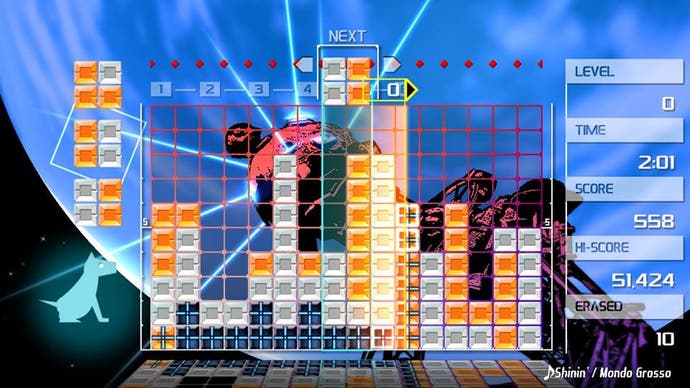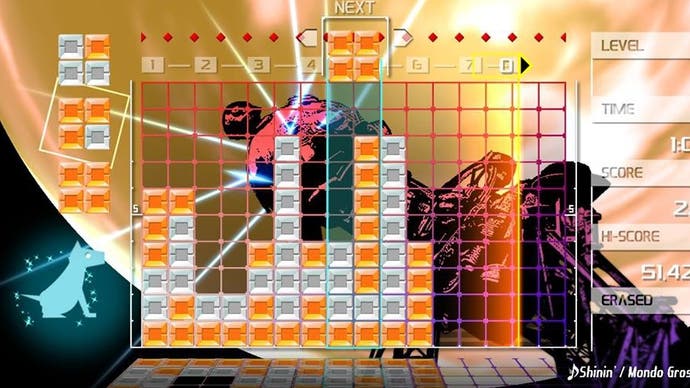In Lumines, your mistakes are golden
It's dynamite!
For two games that are pretty much nothing alike, it's suprisingly easy to find yourself pondering the differences, large and small, between Tetris and Lumines. Yes, one is a marathon while the other is a sprint. And yes, one is about things that collapse while the other is about things that, often maddeningly, remain fixed in place. Playing Lumines Remastered over the weekend, though, sat cross-legged on the bed as though it was 2005 all over again, I was struck by a new point of difference - or rather an old point of difference that I had simply never really noticed before. Something about the texture of your mistakes, I think. Oh yes, it's this: your mistakes feel very different in Tetris and Lumines.
A mistake in Tetris is a terrible thing indeed. This is because of the sprint-like nature, I guess, the fact that Tetris is really the survival horror of the puzzle world. Mistakes stick around in Tetris for a very long time: those gaps remain in the bedrock beneath you, a bit like a group of old friends who are always ready to remind you of a terrible faux pas you made when you were 12 (just me?). The mixture of sprint and fixed in place means that Tetris doesn't forget anything. And it in turns means so much of the game is spent trying to undo earlier mistakes in a bit of a sweaty panic. And of course, because you're in a sweaty panic you make more mistakes. Tetris thrives on mistakes.
So does Lumines, I think, but in Lumines your mistakes are often on your side. Lumines isn't about building a wall to unbuild a wall, it's about growing territory of a certain colour. You rotate the coloured sections of the blocks that fall so that the two colours for each stage will match up harmoniously before the timeline sweeps through. This is why some people get a bit bored with Lumines. They think you can beat the game indefinitely by dividing the screen up into sections and storing block types in specific silos, and inching your way to victory. I have never played golf, but I wonder if these Lumines min-maxers also turn up at Pebble Beach in early Spring or whenever it is people play golf and ask Ed "Porky" Oliver - I Googled him - if he'd considered just faxing the ball over to the hole.

The genius of Lumines only really becomes apparent once the game is alive, and this means, for better or worse, once you've made a bunch of mistakes and have a right load of synaesthesic rubble laid out before you. This rubble will be made up of coloured squares that are so mixed together that they cannot clump into groups. They cannot, to mangle Stoppard, be stirred together. But you must stir them together, and luckily Lumines has a brilliant way of doing just this. I forget what it's actually called, but in our house it's always known as the fuse block, or simply dynamite.
Dynamite is the square that has a little flickering cross on it. It's the same cross, it always seems, that I find myself looking at at the opticians when they're explaining to me that my left eye has pretty much been taking it easy since I was eleven. This cross means that if you match it with other squares of a similar colour you don't need to form 2x2 chains in order for the timeline to clear them. You can form a long, snaking, tumbling chain of single blocks, as long as they are uninterrupted.
What power! What game-changing power. And there are two ways to handle it. You could min-max this, of course, and I always try to at the start of each game, laying a funny little route of orange through the white meat of the opening level, and waiting for the dynamite block to touch it off. But eventually that plan goes wrong and I'm into the second approach - throwing dynamite blocks wildly into the mixed-up rubble of my past mistakes whenever they become available. Sometimes you get nothing, a catherine wheel that refuses to send out anything but a few sparks. Sometimes, though, you get extravagantly lucky and a path that you never even spotted suddenly announces itself, coursing back and forth across the entire screen before the timeline ignites it and the whole thing collapses. At times, Lumines becomes a hymn to mistakes: your mistakes really come alive and reward you.
Gloriously, because you are removing blocks of one colour with dynamite, the collapse often kicks off a gigantic multiplier of the remaining colour. God, it is a beautiful thing. It's a reminder that Lumines, deep down, is really a game about mining, about laying a long fuse through rock and then touching it off. In its own rigid way, Tetris is about mining too, I think, and so is Drop7. Maybe all the really good falling block games are secretly about the pleasures of digging down into the earth and emerging with treasures.


